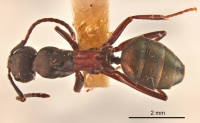Camponotus chalceoides
| Camponotus chalceoides | |
|---|---|

| |
| Scientific classification | |
| Kingdom: | Animalia |
| Phylum: | Arthropoda |
| Class: | Insecta |
| Order: | Hymenoptera |
| Family: | Formicidae |
| Subfamily: | Formicinae |
| Tribe: | Camponotini |
| Genus: | Camponotus |
| Species: | C. chalceoides |
| Binomial name | |
| Camponotus chalceoides Clark, 1938 | |
Identification
Keys including this Species
Distribution
Distribution based on Regional Taxon Lists
Australasian Region: Australia (type locality).
Distribution based on AntMaps
Distribution based on AntWeb specimens
Check data from AntWeb
Countries Occupied
| Number of countries occupied by this species based on AntWiki Regional Taxon Lists. In general, fewer countries occupied indicates a narrower range, while more countries indicates a more widespread species. |

|
Estimated Abundance
| Relative abundance based on number of AntMaps records per species (this species within the purple bar). Fewer records (to the left) indicates a less abundant/encountered species while more records (to the right) indicates more abundant/encountered species. |

|
Biology
Castes
Nomenclature
The following information is derived from Barry Bolton's Online Catalogue of the Ants of the World.
- chalceoides. Camponotus (Myrmophyma) chalceoides Clark, 1938: 376, figs. 14-16 (s.w.) AUSTRALIA (South Australia, Western Australia).
- Type-material: syntype major and minor workers (numbers not stated).
- Type-localities: Australia: South Australia, Reevesby I., 1936 (J. Clark), South Australia, Port Lincoln (no collector’s name; perhaps J. Clark), South Australia, Kyancutta (no collector’s name; perhaps J. Clark), Western Australia, Balladonia (no collector’s name; perhaps J. Clark).
- Type-depository: MVMA.
- Status as species: Taylor & Brown, 1985: 111; Taylor, 1987a: 11; Bolton, 1995b: 91.
- Distribution: Australia.
Type Material
- Camponotus (Myrmophyma) chalceoides Clark, 1938: Syntype, 2 workers, 1 queen, Reevesby Island, South Australia, Australia, Australian National Insect Collection.
- Camponotus (Myrmophyma) chalceoides Clark, 1938: Syntype, 3 workers, Reevesby Island, South Australia, Australia, Museum Victoria, Melbourne.
Unless otherwise noted the text for the remainder of this section is reported from the publication that includes the original description.
Description
Worker major- Length 9.3-9.7 mm. Head, thorax and node metallic bronze-black, gaster iridescent bronze with the anterior and apical margins of segments metallic green, femora and tibiae brownish black, tarsi reddish brown. On several specimens the epinotum more or less red. Mandibles coarsely striate-rugose and punctate, whole body finely and very densely reticulate throughout except on legs, scapes and legs shining, finely punctate. Hair yellow, erect, short and abundant throughout, some extra long hairs on clypeus. Pubescence not apparent. Head as long as broad, occipital border straight, sides convex, angles broadly rounded. Mandibles furnished with four long, broad sharp teeth. Clypeus flatly convex above, strongly projecting in front, convex, with a short deep concave excision in middle. Frontal area triangular, feebly defined. Frontal carinae as long as broad behind, much broader behind than in front, a fine longitudinal groove between them. Scapes extend beyond occipital border by one-fifth their length. First segment of funiculus one-fifth longer than second, remainder sub-equal, apical as long as the two preceding combined. Eyes small, rather flat, their anterior edge behind the middle of sides. Anterior ocellus very small, placed in a large puncture, posterior ocelli lacking. Thorax barely twice as long as broad, sutures sharply impressed. Pronotum two and one-half times broader than long, sides, front and top strongly convex, concave behind. Mesonotum slightly broader than long, almost circular, strongly convex in all directions. Spiracles prominent. Epinotumslightly longer than broad, strongly convex transversely; in profile pronotum strongly convex from apex to base. Mesonotum feebly convex, highest in front. Epinotumfeebly concave in middle one and one half times longer than declivity into which it is rounded. Node fully twice as broad as long, bluntly pointed above, sides and anterior face convex, posterior face straight; in profile twice as high as long, anterior and posterior faces convex, bluntly pointed above. Gaster longer than broad. First segment twice as broad as long, strongly convex in front, almost hemispherical. Legs long and slender.
Worker media - Length 7.5-8 mm. Color, sculpture and pilosity as in the major, with the epinotummore often rose-red. Head one-fifth longer than broad, sides almost parallel. Scapes extend beyond occipital border by one-third their length.Epinotum in profile, much more concave, and lower than mesonotum. Node thicker, more rounded on top.
Worker minor - Length 6.5-7 mm. Color, sculpture and pilosity as in the major, epinotum red. Head, one fifth longer than broad, strongly convex behind eyes, sides convex. Scapes extend beyond occipital border by half their length, epinotum more concave than in major and media, and node thicker, convex on top.
Habitat - Reevesby Island. South Australia: Port Lincoln, Kyancutta. Western Australia: Balladonia.
Several nests were found in rotten trees on Reevesby Island. Many single examples of the worker minor have been received in the past from other localities. This species is more highly colored than Camponotus chalceus Crawley from Western Australia, but has a slight resemblance.
References
- Bolton, B. 1995b. A new general catalogue of the ants of the world. Cambridge, Mass.: Harvard University Press, 504 pp. (page 91, catalogue)
- Clark, J. 1938. The Sir Joseph Banks Islands. Reports of the McCoy Society for Field Investigation and Research. Part 10. Formicidae (Hymenoptera). Proc. R. Soc. Vic. (n.s.) 50: 356-382 (page 376, figs. 14-16 soldier, worker described)
References based on Global Ant Biodiversity Informatics
- Clark J. 1938. The Sir Joseph Banks Islands. Reports of the McCoy Society for Field Investigation and Research. Part 10. Formicidae (Hymenoptera). Proceedings of the Royal Society of Victoria (n.s.)50: 356-382.
- Taylor R. W. 1987. A checklist of the ants of Australia, New Caledonia and New Zealand (Hymenoptera: Formicidae). CSIRO (Commonwealth Scientific and Industrial Research Organization) Division of Entomology Report 41: 1-92.
